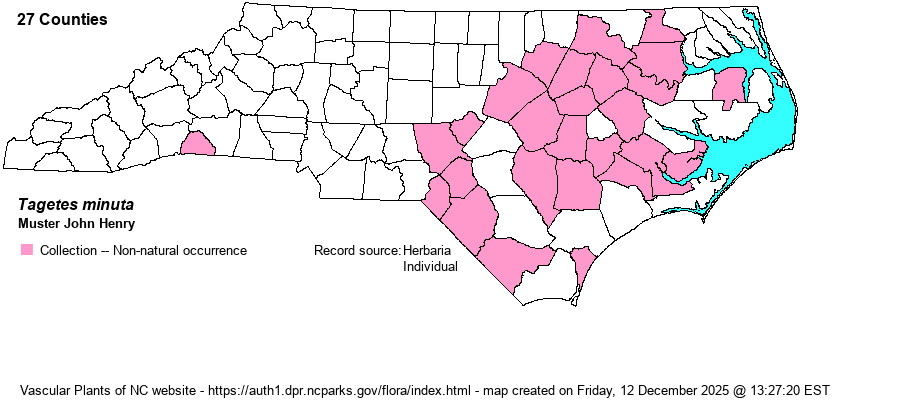| Author | L. | |
| Distribution | Throughout most of the Coastal Plain, but scarce in the Sandhills and lower Piedmont; disjunct to Polk County. First collected in 1938, most recently in 1967 -- a curiously short period of time for such a widespread plant. "Re-discovered" in September 2020 by Bruce Sorrie in the Sandhills of Moore County--a life plant for him.
Native of South America; in N.A. MA to PA, FL, and AL; Ont.; CA-AZ. | |
| Abundance | Uncommon and apparently strongly declining in the Coastal Plain; rare in the upper Piedmont. Few recent collections, though this is possibly due to apathy in counties where historically collected. | |
| Habitat | Fields, farms, roadsides, shore of millpond, garden weed. | |
| Phenology | Flowering and fruiting September-November. | |
| Identification | Marigolds are aromatic, glabrous herbs with pinnately dissected leaves. Muster John Henry grows 3-6 feet tall and is pungently aromatic. It differs significantly from our others in its very small, narrowly cylindrical heads and very small, white or pale yellow ray florets. In fact, to most people, it simply does not look at all like a marigold (Tagetes); even an experienced botanist would likely be confused by what genus the plant resides in. | |
| Taxonomic Comments | | |
| Other Common Name(s) | Southern Cone Marigold, Mexican Marigold | |
| State Rank | SE | |
| Global Rank | GNR | |
| State Status | | |
| US Status | | |
| USACE-agcp | | |
| USACE-emp | | |

